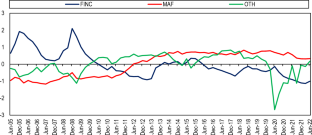Impact of macroprudential policy on economic growth in Indonesia: a growth-at-risk approach
IF 2.5
Q2 ECONOMICS
引用次数: 0
Abstract
Macroprudential policy yields important benefits in terms of preventing and mitigating systemic risk, but it can also have an impact on economic growth, particularly on the left tail of the growth distribution. In this context, policymakers need to consider the effects of macroprudential policies on the entire growth distribution, and not only on average growth. The growth-at-risk (GaR) approach represents a useful framework for such an assessment. This paper describes the use of the GaR method and illustrates its implementation for assessing the impact of macroprudential policy on GaR in Indonesia. As a first step, I select 26 macrofinancial variables that are relevant for the Indonesian economy and build three partitions that capture financial conditions, macrofinancial vulnerabilities and other relevant factors. Results from quantile regressions have important policy implications, suggesting that an early tightening of macroprudential policy would reduce downside risks to Indonesia’s gross domestic product (GDP) growth by increasing the resilience of the financial system. Results further show that a materialization of risk, stemming from either a loosening of financial conditions, an increase of macrofinancial vulnerabilities or a deterioration of the macroeconomic environment have important effects on Indonesia’s GDP growth distribution and particularly on the left tail of the distribution, which represents the GaR. Under each of these scenarios, a tightening or loosening of the macroprudential stance, depending on the underlying vulnerabilities, yields high benefits in terms of improving Indonesia’s GaR, which range from 0.06 and 0.14 percentage points.

宏观审慎政策对印尼经济增长的影响:一种风险增长方法
宏观审慎政策在预防和减轻系统性风险方面具有重要的效益,但它也可能对经济增长产生影响,特别是对增长分布的左尾。在这种背景下,政策制定者需要考虑宏观审慎政策对整个增长分配的影响,而不仅仅是对平均增长的影响。风险增长(GaR)方法为这种评估提供了一个有用的框架。本文描述了GaR方法的使用,并说明了其实施情况,以评估印度尼西亚宏观审慎政策对GaR的影响。作为第一步,我选择了26个与印尼经济相关的宏观金融变量,并构建了三个分区,分别捕捉金融状况、宏观金融脆弱性和其他相关因素。分位数回归的结果具有重要的政策意义,表明早期收紧宏观审慎政策将通过提高金融体系的弹性来降低印尼国内生产总值(GDP)增长的下行风险。结果进一步表明,由金融条件放松、宏观金融脆弱性增加或宏观经济环境恶化引起的风险具体化,对印度尼西亚的GDP增长分布产生了重要影响,特别是对分布的左尾(即GaR)产生了重要影响。在每一种情况下,根据潜在的脆弱性,收紧或放松宏观审慎立场,在提高印尼的GaR方面都会产生很高的效益,其范围在0.06到0.14个百分点之间。
本文章由计算机程序翻译,如有差异,请以英文原文为准。
求助全文
约1分钟内获得全文
求助全文
来源期刊

Eurasian Economic Review
ECONOMICS-
CiteScore
6.00
自引率
2.90%
发文量
24
期刊介绍:
The mission of Eurasian Economic Review is to publish peer-reviewed empirical research papers that test, extend, or build theory and contribute to practice. All empirical methods - including, but not limited to, qualitative, quantitative, field, laboratory, and any combination of methods - are welcome. Empirical, theoretical and methodological articles from all fields of finance and applied macroeconomics are featured in the journal. Theoretical and/or review articles that integrate existing bodies of research and that provide new insights into the field are highly encouraged. The journal has a broad scope, addressing such issues as: financial systems and regulation, corporate and start-up finance, macro and sustainable finance, finance and innovation, consumer finance, public policies on financial markets within local, regional, national and international contexts, money and banking, and the interface of labor and financial economics. The macroeconomics coverage includes topics from monetary economics, labor economics, international economics and development economics.
Eurasian Economic Review is published quarterly. To be published in Eurasian Economic Review, a manuscript must make strong empirical and/or theoretical contributions and highlight the significance of those contributions to our field. Consequently, preference is given to submissions that test, extend, or build strong theoretical frameworks while empirically examining issues with high importance for theory and practice. Eurasian Economic Review is not tied to any national context. Although it focuses on Europe and Asia, all papers from related fields on any region or country are highly encouraged. Single country studies, cross-country or regional studies can be submitted.
 求助内容:
求助内容: 应助结果提醒方式:
应助结果提醒方式:


